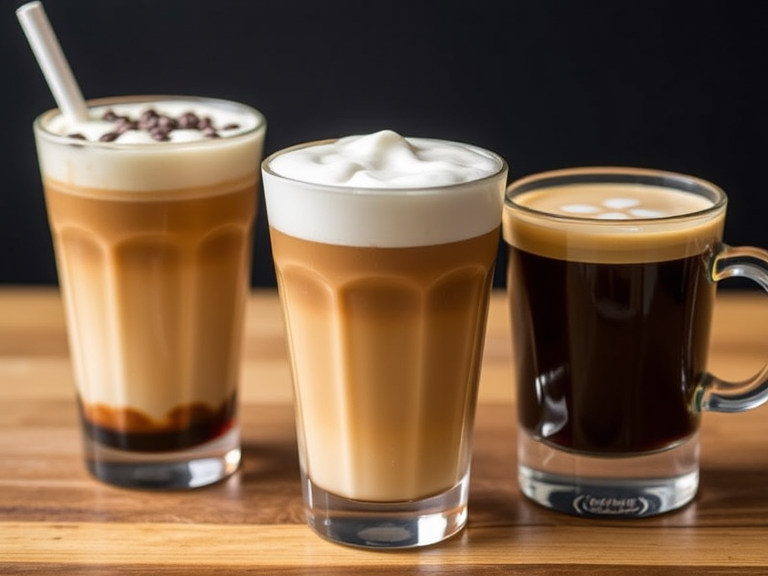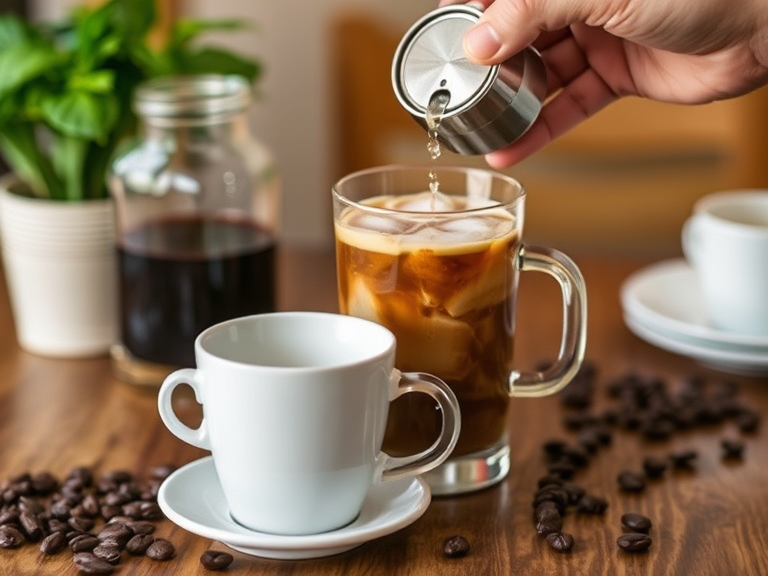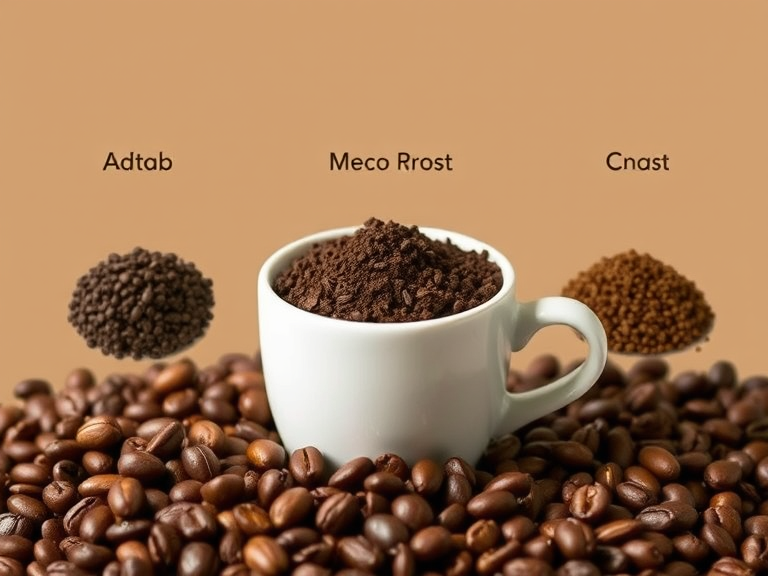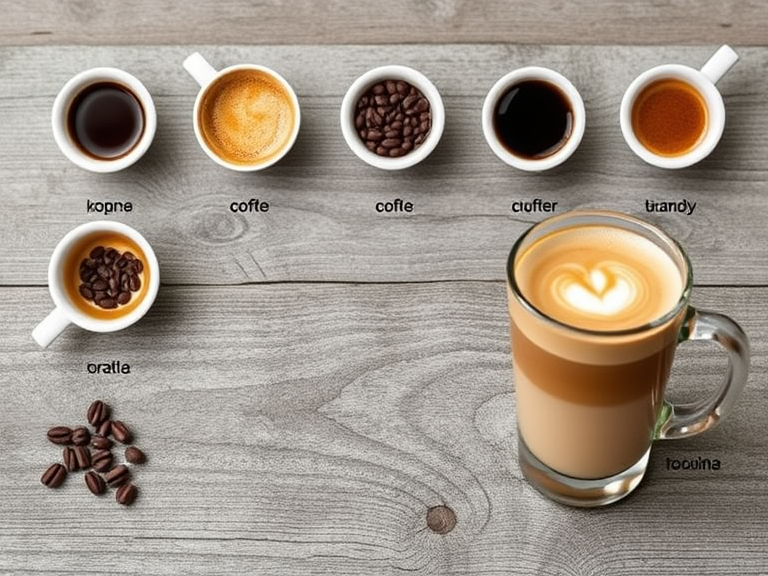Coffee is more than just a morning beverage – it’s a world of diverse flavors, preparation methods, and cultural traditions.
Also Read: The Definitive List of Every Type of Coffee
This comprehensive guide explores every major type of coffee drink you might encounter, from classic espresso-based beverages to regional specialties.
Basic Coffee Preparations
The foundation of every coffee drink starts with how the coffee is initially prepared. Understanding these basic methods helps us appreciate the more complex drinks that build upon them.
Drip Coffee
Drip coffee remains the most common brewing method in homes and offices across North America. Hot water slowly filters through ground coffee beans, creating a clean and straightforward cup. This method brings out the coffee’s natural flavors without adding complexity.
French Press Coffee
French press brewing creates a fuller-bodied coffee with more oils and intense flavors. The metal mesh filter allows natural oils to pass through, resulting in a richer mouthfeel compared to paper-filtered methods. This method works especially well with medium to dark roast beans.
Pour-Over Coffee
Pour-over coffee offers precise control over brewing variables. The barista manually pours hot water over ground coffee in a circular motion, ensuring even extraction. This method produces a clean, bright cup that highlights the coffee’s subtle flavor notes.
Espresso-Based Drinks

Espresso serves as the foundation for many popular coffee beverages. These drinks combine the concentrated coffee shot with various amounts of milk and other ingredients.
Classic Espresso
A single shot of espresso contains concentrated coffee brewed under pressure. It features a golden-brown crema on top and delivers intense flavor in a small volume. Good espresso should taste balanced, not bitter.
Americano
An Americano combines espresso with hot water, creating a drink similar in volume to drip coffee. This preparation method preserves the espresso’s rich flavors while making them more approachable. The drink originated during World War II when American soldiers in Italy diluted espresso to approximate familiar drip coffee.
Cappuccino
The cappuccino consists of equal parts espresso, steamed milk, and milk foam. The traditional Italian preparation creates distinct layers in the cup. Modern interpretations might vary these proportions slightly, but the drink always maintains its characteristic balance.
Latte
A latte contains more steamed milk than a cappuccino, with just a small layer of foam on top. This ratio creates a creamier, more milk-forward drink. Baristas often create decorative patterns in the foam, known as latte art.
Flat White
The flat white originates from Australia and New Zealand. It features espresso and microfoam milk, creating a velvety texture throughout the drink. The milk is steamed to create smaller bubbles than in a traditional latte.
Milk Variations
Different approaches to milk preparation create distinct coffee experiences. Understanding these variations helps you choose the right drink for your taste preferences.
Macchiato
A traditional macchiato adds just a small amount of steamed milk to espresso. This “marked” espresso maintains the coffee’s strength while slightly softening its edge. Modern coffee shop versions might include more milk and flavored syrups.
Mocha
Mocha combines espresso, steamed milk, and chocolate syrup. This sweet drink often includes whipped cream on top. The combination pays homage to coffee’s historical connection to the Yemeni port of Mocha.
Breve
A breve uses half-and-half instead of whole milk, creating a vibrant drink. The higher fat content produces luxurious foam and a decadent taste. This variation remains more common in North America than in Europe.
Cold Coffee Preparations

Cold coffee drinks offer refreshments while delivering caffeine and coffee flavors. These preparations have gained popularity in recent years.
Cold Brew
Cold brew steeps coffee grounds in cold water for 12-24 hours. This gentle extraction method creates a smooth, less acidic drink. The resulting concentrate can be diluted with water or milk.
Iced Coffee
Traditional iced coffee starts with regular hot coffee that’s cooled and served over ice. This method preserves the coffee’s familiar taste while creating a refreshing drink. Adding milk or sweeteners remains common.
Nitro Cold Brew
Nitro cold brew infuses cold brew coffee with nitrogen gas. This process creates a creamy mouthfeel and cascading effect similar to draft beer. The drink typically appears darker and richer than regular cold brew.
Regional Specialties
Coffee culture varies worldwide, producing unique preparation methods and flavor combinations. These regional variations reflect local tastes and traditions.
Turkish Coffee
Turkish coffee uses very finely ground beans boiled with water and often sugar. The unfiltered preparation method creates a thick, intense drink with grounds settling at the bottom. This traditional preparation requires specific equipment and techniques.
Vietnamese Coffee
Vietnamese coffee combines strong drip coffee with sweetened condensed milk. The preparation uses a metal filter called a phin, which sits directly on the serving glass. The resulting drink offers a bold coffee flavor balanced by rich sweetness.
Greek Frappé
Greek frappé whips instant coffee with sugar and water to create a foam-topped cold drink. This modern invention became a cultural phenomenon in Greece. The drink usually includes ice and sometimes milk.
Flavored Coffee Variations
Coffee serves as a base for countless flavor combinations. These variations add new dimensions to the basic drink.
Seasonal Favorites
- Pumpkin Spice Latte: Combines espresso, steamed milk, and pumpkin spice flavoring
- Peppermint Mocha: Features espresso, chocolate, and cooling peppermint notes
- Caramel Macchiato: Layers of vanilla syrup, milk, espresso, and caramel drizzle
Coffee Roast Types

The roasting process significantly impacts the coffee’s final flavor. Understanding these differences helps choose beans that match your taste preferences.
Light Roast
Light roast beans maintain more of their original flavor characteristics. These coffees often feature bright, acidic notes and higher caffeine content. The beans appear dry and light brown.
Medium Roast
Medium roast creates a balanced flavor profile. These beans develop some oils on their surface and offer both origin flavors and roasting notes. This popular roast level works well in most brewing methods.
Dark Roast
Dark roast produces bold, intense flavors with prominent roasting notes. The beans appear very dark and oily. These coffees typically taste less acidic but might seem bitter to some people.
Frequently Asked Questions
What’s the strongest type of coffee?
Espresso contains the most concentrated coffee flavor, while light roast beans contain slightly more caffeine by volume.
Which coffee drink has the most milk?
The latte typically contains the most milk among traditional coffee drinks, with a ratio of about 1:3 espresso to steamed milk.
How is cold brew different from iced coffee?
Cold brew uses room-temperature water and long steeping times, while iced coffee starts hot and gets cooled down, resulting in different flavor profiles.
What’s the difference between a latte and a cappuccino?
Cappuccinos have equal parts espresso, steamed milk, and foam, while lattes use more steamed milk and less foam.
Which coffee drink is best for beginners?
A latte or cafe au lait offers a gentle introduction to coffee flavors, as the higher milk content creates a smoother, less intense taste.
Conclusion
The world of coffee offers endless variations to explore, from simple drip coffee to complex espresso-based drinks and regional specialties.
Also Read: The Definitive List of Every Type of Coffee
Each preparation method brings out different aspects of coffee’s rich flavor potential.
Whether you prefer the pure taste of black coffee or enjoy creative milk-based drinks, understanding these various types helps appreciate coffee’s diversity.
As coffee culture continues evolving, new variations emerge while traditional preparations maintain their timeless appeal.
This guide serves as a starting point for coffee exploration, encouraging coffee lovers to try different preparations and find their perfect cup.

